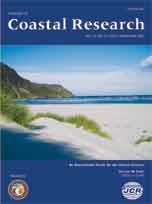Ivan, a strong Category 4 hurricane (downgraded to a Category 3 at landfall), caused widespread erosion and overwash along the northwestern Florida barrier-island beaches. This study examines the storm impact and short-term post-storm recovery along a 200-km stretch of coast from Fort Walton Beach eastward to St. George Island. One prestorm and three poststorm beach-profile surveys were conducted to quantify the storm-induced morphological changes and poststorm recovery. Forty-six trenches were excavated to study the characteristics and thickness of subaerial storm deposits.
Extensive inundation and overwash occurred within 100 km from the storm center at landfall. Significant beach/dune erosion was measured as far as 300 km east of the storm center. The highest elevation of beach erosion extended considerably above the measured storm-surge level, indicating that storm-wave setup and swash run-up played significant roles in controlling the elevation of beach erosion. A simple empirical formula reproduced the wave setup and swash run-up reasonably well. Beach recovery began immediately after the storm. Within 90 days, the berm crest recovered to its prestorm elevation, although it was now located approximately 15 m landward for nonoverwashed sites and 30 to 40 m for overwashed sites. The steep prestorm foreshore slope was restored from the gentle storm profile within 30 days.
An apparent erosional surface was observed along the impacted foredune and backbeach, extending over 300 km eastward from the storm center. This erosional surface represents a net elevation loss ranging from 0.5 to over 2.0 m. A storm layer of up to 50 cm thick was deposited above the erosional surface. Generally, the storm-layer thickness decreases away from the storm center, as well as landward from the high tide line. Local factors such as beach width and orientation, and sediment properties and supply caused variations in the thickness of storm deposit.





